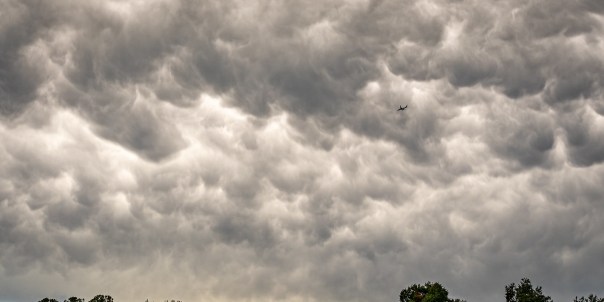I was on my way home through some rain one day last week when the sky started to look very interesting. I stopped by the house, picked up a camera (I know – I should have had it with me!) and headed up toward Lake Jesup to make a few photos. I’m glad I did – the clouds got even more dramatic!
 Squall Line
Squall LineThey were developing quickly. These photos were all made within about 40 minutes.
 On the way
On the wayThe clouds varied in different spots and directions. I stopped several times to make photos.
 Weather across the water
Weather across the waterThis last photo is of some mammatus clouds. If you click on it to view a larger version on Flickr, you can see an airliner flying just below the clouds. I hope passengers were getting a good view and the ride wasn’t too bumpy.
 Into the Mammatus Sky
Into the Mammatus SkyThe last time I wrote specifically about photographing Florida weather was in 2015: (https://edrosack.com/2015/10/17/photographing-florida-weather/). I think the weather photo hints from that post are still relevant:
- Although you can see interesting weather all year, the best time here is summer afternoons and evenings.
- The storms are big. Many times I find myself using a wide-angle lens or stitching panoramas for this kind of photography. The photos in this post were made with a 20mm lens. Some situations (like this thunderstorm) benefit from a longer focal length.
- You can shoot from inside your car in many cases or just dodge the showers. Bring a lens cloth and maybe a towel or some plastic to cover your camera if it’s not weather resistant.
- Be careful with exposure. If you have clear sky behind the clouds you can easily blow out highlights in the image which will be tough to fix in post.
- When processing your photos, try using some mid-range contrast / clarity to bring out details in the clouds. Don’t go too far though or your results will look unrealistic.
- Find yourself some good foreground locations in advance so you’ll be ready to head out when the weather gets interesting.
- And be careful – don’t get struck by lightning or ruin your equipment!
Clouds and weather are often threatening and dangerous. But sometimes they’re interesting and beautiful. Be careful, and if they develop, make some photos.
You can browse more weather related posts on the blog at this link: https://edrosack.com/?s=weather. If you click on the photos above, you can see larger versions on Flickr. I’ve also collected other Florida Cloud and Storm photos that you can browse in this set.
Thanks for stopping by and reading my blog. Take care of yourselves and each other. And when you can, make some photos!
Header image: Clouds over the hill. Larger version here: https://www.flickr.com/photos/edrosack/51310975255/in/dateposted-public/
©2021, Ed Rosack. All rights reserved




















































